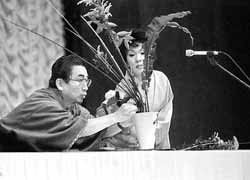Believes the Japanese ikebana master

Last Saturday Professor of the Ikenobo School Ito Masao and Ms. Yamada Midori performed a demonstration of the traditional Japanese art of arranging the flowers at the Ukrainian House. The spectators could watch the process of creating a miracle named ikebana. The compositions varied from traditional rikka style to the more modern ones. Rikka was the main form of ikebana until the seventeenth century. Literally rikka means standing flowers. Branches and flowers in such compositions are directed upwards and symbolize fate. Pine tree, cedar, cryptomeria (Japanese cedar), or bamboo usually are used as material. A composition cannot have more than seven components or five plant species. Rikka shows the beauty of Japanese landscape: mountainside at the seacoast near Kyoto.
It takes a long time to prepare the material for ikebana, although the composition itself is created in few minutes. For instance, at the Ukrainian House hall ten absolutely different compositions came into existence in ninety minutes. Professor Ito noted, “The selection of material is very important in creating ikebana: you must notice interesting lines. An arranger can spend a whole day to find it. However, today we were limited in time, thus the material was presented by Kyiv Botanical Garden.”
Traditional composition has precise shape. According to Ito Masao, he makes a good ikebana when inspiration comes to him from heaven; it is practically impossible to create a quality composition off the cuff.
“I can take any material for my compositions,” Mr. Ito says. “For example, yellow leaves, even damaged ones, can bear more information. It is like an old man’s experience: though old, he fights for his life and has something to share with the young.”
The major principle of Japanese art is the idea of eternal life and the growth of life power. The word, ikebana, comes from the words ike, which means living, and hana or bana meaning a flower. Ikebana in Japanese means to help flowers fulfill themselves. The art of ikebana professes a love for line, trying to show its impeccable nature and natural quality. Ikebana consists of three principal components: natural material, vase, and kenzan flower holder to fix the composition. Usually some tree branches and flowers are used in a composition. Only strong unblown flower buds can be a part of it.
Ikenobo school has a history of 500 years. It takes its rise in Kyoto Rokkakudo Temple, which was founded by Prince Shotoku and dedicated to Nyorin Kannon, Buddhist goddess of mercy. Ikenobo literally means a hut (bo) near a pond (ike), alluding a pond where Prince Shotoku once bathed. Now the forty-fifth generation of ikebana masters of Ikenobo school arrived.
Forty-five Rokkakudo monks bearing the name of Ikenobo taught their art to other people, laying the foundation for ikebana art. Primarily it was open only to the favored few, exclusively men. However, since the seventeenth century people at large obtained access to it. Women have made great success in this field. In part, at the last Saturday’s demonstration it was women who helped Professor Ito to create his small miracle. Today the Ikenobo school numbers 3 million pupils, 400 of which live in the CIS states. More and more adherents of this art appear in Ukraine.
Progress in flower arrangement was achieved in the days of shogun Yoshimasa, who rejected complicated architectural styles and worked out simple rules for ikebana together with the artist Samai. He hoped to give everybody a chance to enjoy its beauty. This new type of arrangement was called seiwa.
In the late seventeenth century a new, free nageire arrangement style developed. In this style flowers can touch vase’s edges, they can be placed in a more natural way, and the attitude toward plants is less strict. The goal is to show the beauty of any given material.
The shoka, or seika, style appeared in the early seventeenth century, influenced by Zen Buddhism and the tea ceremony, and became a counterweight to rikka’s grandeur. Though difficult to master, it is rather popular.
The twentieth century brought a new moribana style influenced by Western culture. Its followers aim to recreate the beauty of a landscape in miniature, combining elements of both the rikka and nageire schools.
The secret of ikebana creating is forming two controversial streams, attracting and repelling, which are present in any human soul. Using the power of every branch or flower, uniting their size, shape, and color, we can get an organic unity.
To conclude his demonstration, Professor Ito created two compositions symbolizing the Japanese and Ukrainian national flags. He ended the show with the words, “Ikebana is a boundless art, so study ikebana, think through ikebana, make friends through ikebana.”






